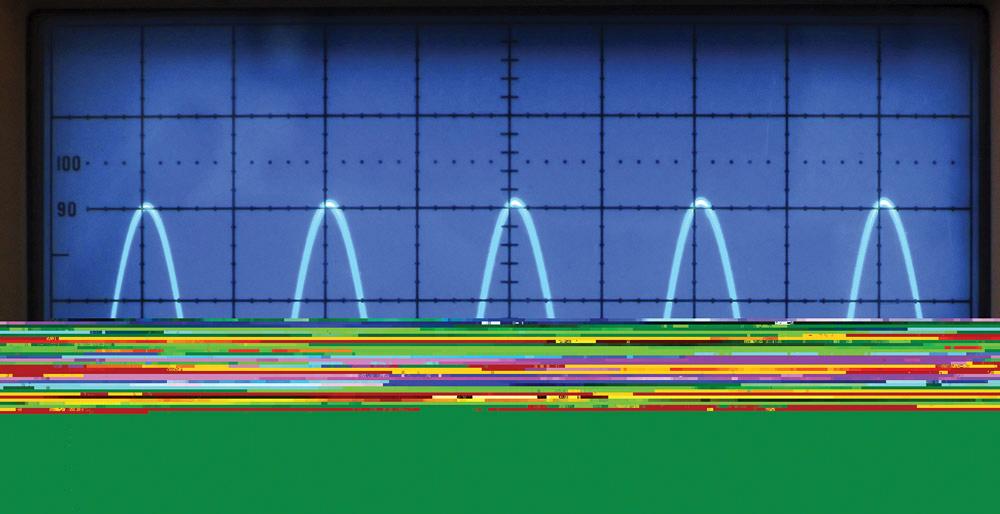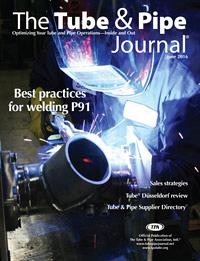Regional Sales Specialist
- FMA
- The Fabricator
- FABTECH
- Canadian Metalworking
Categories
- Additive Manufacturing
- Aluminum Welding
- Arc Welding
- Assembly and Joining
- Automation and Robotics
- Bending and Forming
- Consumables
- Cutting and Weld Prep
- Electric Vehicles
- En Español
- Finishing
- Hydroforming
- Laser Cutting
- Laser Welding
- Machining
- Manufacturing Software
- Materials Handling
- Metals/Materials
- Oxyfuel Cutting
- Plasma Cutting
- Power Tools
- Punching and Other Holemaking
- Roll Forming
- Safety
- Sawing
- Shearing
- Shop Management
- Testing and Measuring
- Tube and Pipe Fabrication
- Tube and Pipe Production
- Waterjet Cutting
Industry Directory
Webcasts
Podcasts
FAB 40
Advertise
Subscribe
Account Login
Search
Advanced GMAW processes help in welding P91
Modified waveforms cut training time, improve deposition rate
- By Dan Hernandez and David Benson
- May 26, 2016
- Article
- Tube and Pipe Fabrication
Increasingly demanding material requirements found in piping and boiler construction for industries such as power generation and petrochemical processing have made a specific type of chromium-molybdenum steel pipe—referred to as grade P91—a frequent choice because of its ability to withstand high pressures and high temperatures. Alloy P91 is used in many critical applications that require significant strength at high temperatures, including superheaters, headers, and steam lines.
However, P91 is a higher-cost material that presents some challenges in fabrication. Achieving sound welds with P91 pipe requires operator skill; careful control of heat input before, during, and after welding; and appropriate low-hydrogen filler metals.
Contractors usually use traditional processes to weld this material, specifically gas tungsten arc welding (GTAW, also known as tungsten inert gas, or TIG) and shielded metal arc welding (SMAW, also known as stick). However, converting to gas metal arc welding (GMAW, also known as metal inert gas, or MIG) processes such as modified short-circuit GMAW, pulsed GMAW, and flux-cored arc welding (FCAW) can save significant time, reducing the welding time by half on some jobs and cutting the time needed to train new welders.
This is due to several factors, including increased travel speeds and deposition rates, ease of use, and the ability to eliminate the back purge in some cases. This helps contractors improve profitability and be more competitive without sacrificing weld quality.
P91 Basics
P91 is a type of creep-strength-enhanced ferritic (CSEF) alloy—a steel designed to retain strength at extremely high temperatures. The P91 abbreviation represents the material’s chemical composition: 9 percent chrome and 1 percent molybdenum.
The material is used in high-temperature, high-pressure steam piping for two primary reasons: It retains strength at elevated temperature and it resists failure caused by creep, which is the tendency of a solid material to move slowly or deform permanently under the influence of mechanical stresses. This alloy also resists corrosion better than the other alloys previously used in these applications.
Because of the critical nature of these power boiler applications, any defects in the weld can result in cracking and eventual part failure. Failures in high-pressure steam pipe can be catastrophic, causing ruptures, tank or valve explosions, and other serious incidents that can result in fatal injuries. As a result, codes and procedures for P91 applications are stringent.
Control the Heat
While CSEF alloys such as P91 are designed to maintain strength at elevated temperatures, one of the biggest challenges in welding P91 is the material’s sensitivity to heat changes during the welding process. It’s critical to control the heat input before, during, and after welding. Too much or too little heat can lead to issues with cracking in the heat-affected zone (HAZ) and premature weld failure.
The HAZ is a region of potential weakness and a major factor in the quality and service life of the weld. The material’s cooling rate influences the material’s microstructure. Preheating helps drive off moisture and reduce hydrogen, and it reduces the thermal difference between the base material and the weld puddle. This improves weldability and prevents the weld pool from cooling too quickly. Typically P91 must be preheated to a temperature from 400 to 600 degrees F, though the appropriate heating level depends on the specific qualified weld procedure for the application.
uring the welding process, it’s equally important to keep the temperature within the range specified by the weld procedure. If the interpass temperature is allowed to fall outside the approved range, cracking may occur; if it gets too hot, the material can lose its strength and toughness. Working at the low end of the approved temperature range is preferred to keep the HAZ to a minimum. The more heat applied and the longer heat is applied, the larger the HAZ, which can increase opportunities for cracking.

Figure 1
A change in welding processes can lead
to significant productivity gains in P91 applications.
Using a modified short-circuit
GMAW process such as Regulated Metal
Deposition (RMD®) from Miller Electric Mfg.
Co. increases travel speeds three to four
times compared to conventional methods.
Another critical step is postweld heat treatment, which improves the material’s microstructure. The heat of the welding process makes the weld deposit nd neighboring HAZ brittle when welding P91. Postweld heat treatment restores toughness to the weld deposit and the HAZ.
Because precision and stability in temperature control are important when welding P91 pipe, induction heating is well-suited to this application for its control and uniformity of heating. Induction, a form of electric preheat, does not rely on a heating element or flame to transfer heat. Instead, an alternating current passes through the induction coil, creating a magnetic field around it. As the magnetic field passes through the workpiece, it creates eddy currents within the part, and the part’s resistance to these currents generates the heat in the part. The heat is created within the workpiece, which makes induction very efficient since little heat is lost in the process.
Because induction maintains uniform heating through the heat zone, it reduces the potential for hot and cold spots in the part. Induction systems also allow welding operators to check and adjust the temperature as needed and to document preheat, interpass, and postweld temperature levels for quality assurance, code requirements, or customer specifications.
Unconventional GMAW Processes
Another factor that can contribute to P91 weld quality, productivity, and efficiency is the welding process used. Advanced GMAW processes such as modified short-circuit GMAW and pulsed GMAW can help contractors improve profitability and be more competitive.
A modified short-circuit GMAW process anticipates and controls each short circuit, then reduces the available welding current to create a consistent metal transfer. The result is uniform droplets, creating only small ripples in the weld puddle and producing a consistent tie-in to the sidewall. It also maintains a consistent arc length regardless of stick-out, within practical limits, which makes it easier for welders to control and manipulate the puddle, improving weld consistency and quality.
Root Pass. In some cases, a modified short-circuit GMAW process used for the root pass doesn’t require a back purge because of the consumables used and the lower heat input. In contrast, GTAW on P91 typically requires an argon back purge during and after the root pass. Eliminating this reduces gas consumption and eliminates the purge time (see Figure 1).
Hot Pass. Advanced-waveform GMAW provides a thicker root deposit than other processes, which helps eliminate the hot pass, thereby reducing the risk of burn-through on the subsequent fill passes. This also helps eliminate the need for a back purge.
Fill and Cap. Pulsed GMAW and FCAW for the fill and cap passes are faster than conventional processes.
While switching to these processes may require an investment in operator training, the processes are considered easy to learn, leading to greater productivity and reduced need for highly skilled labor.“If it ain’t broke, don’t fix it” doesn’t apply here. Conventional welding processes aren’t broken, but industry pressures such as the skilled labor shortage, decreasing project timelines, and greater focus on cost control are making them uncompetitive for many specialized applications, including P91.
The Filler Metal X-factor
Another factor in successfully welding P91 is choosing the right filler metal. High-quality P91 welds require the correct chemical composition in the weld metal.
First, datasheets for all chrome-moly filler metals should provide a typical X-factor designation for the product. This formula measures a weldment’s resistance to temper embrittlement. The number is calculated from the amounts of four key contaminants in steel: phosphorous (P), antimony (Sb), tin (Sn), and arsenic (As):
X = (10P + 5Sb + 4Sn + As)/100.
It’s especially important to know the X-factor of a filler metal when welding certain chrome-moly steels, such as P91. A filler metal with an X-factor lower than 15 is suitable for P91 applications.
Second, because controlling hydrogen in the weld prevents hydrogen-induced cracking, the filler metal must be a low-hydrogen product intended for joining high-strength chrome-moly materials.
Third, it’s a good idea to know what’s in a specific lot of filler metal. A recommended practice is to purchase filler metal only if it’s accompanied by a chemical analysis report that pertains to the specific heat and lot purchased.
About the Authors
Dan Hernandez
1635 W. Spencer St.
Appleton, WI 54912
920-734-9821
David Benson
Applications Engineer
101 Trade Square East
Troy, OH 45373
937-332-4000
About the Publication
Related Companies
subscribe now

The Tube and Pipe Journal became the first magazine dedicated to serving the metal tube and pipe industry in 1990. Today, it remains the only North American publication devoted to this industry, and it has become the most trusted source of information for tube and pipe professionals.
start your free subscription- Stay connected from anywhere

Easily access valuable industry resources now with full access to the digital edition of The Fabricator.

Easily access valuable industry resources now with full access to the digital edition of The Welder.

Easily access valuable industry resources now with full access to the digital edition of The Tube and Pipe Journal.
- Podcasting
- Podcast:
- The Fabricator Podcast
- Published:
- 04/16/2024
- Running Time:
- 63:29
In this episode of The Fabricator Podcast, Caleb Chamberlain, co-founder and CEO of OSH Cut, discusses his company’s...
- Trending Articles
Team Industries names director of advanced technology and manufacturing

Orbital tube welding webinar to be held April 23

3D laser tube cutting system available in 3, 4, or 5 kW

Corrosion-inhibiting coating can be peeled off after use

Brushless copper tubing cutter adjusts to ODs up to 2-1/8 in.

- Industry Events
16th Annual Safety Conference
- April 30 - May 1, 2024
- Elgin,
Pipe and Tube Conference
- May 21 - 22, 2024
- Omaha, NE
World-Class Roll Forming Workshop
- June 5 - 6, 2024
- Louisville, KY
Advanced Laser Application Workshop
- June 25 - 27, 2024
- Novi, MI



























